History
A Brief History of the MG Midget
Presumably if you’re reading this you are already the owner of an MG, or at least a member of the MGCC, so are familiar with MG’s if not necessarily the Midget. Should that be the case and you’ve ever wondered what they are like, then this is for you. It has been said, and justifiably, that the Sprite and Midget as produced by the MG Car Company from 1958 until 1979, provided motoring enthusiasts with by far the most amount of enjoyment, for by far the least amount of money. One of the most versatile sports cars ever, owners were within days of its announcement, competing successfully with them in all branches of motor sport, and have continued doing so ever since. Equally at home whether being used for racing, rallying, hillclimbing, sprinting, trialling, or auto-testing, these diminutive machines were and are truly competitive, and in talented hands always capable of some giant slaying results. A joy to drive, easy and inexpensive to buy and repair, these little machines represent the ultimate enthusiasts all rounder. A true “sports car” in every sense of the word.
History
The name “Midget” was first used by MG in 1929 ascribed to the M Type, this being MG’s first baby sports car based on the then newly released Morris Minor. Rapid development of the overhead cam sports and racing cars through the early 1930’s led to subsequent C ,D, J, P, Q, and R type Midgets, this being MG’s most exciting period. Then came the first of the T Type Midgets the TA in late 1936, culminating with the TF model of 1954. When the TF’s successor, the MGA, was being planned, it was considered the car had by now grown too large to be referred to as a Midget any longer, and so the name was dropped, not being revised until the new semi-monocoque car was launched in 1961.
The first ‘modern’ Midget was essentially a re-badged Austin Healey Sprite MkII which itself was a development from the the original 1958 MkI Sprite, more frequently known as the Frogeye.
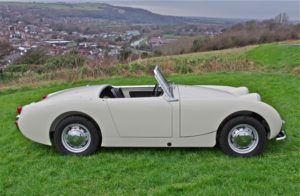
Mk 1 “Frogeye” Sprite
The MkI Midget, as announced in June 1961 and fitted with a 46.5bhp 948cc BMC “A” series engine was quite basic, with a very simple interior, sidescreens and stowaway hood. However it did just what its creators intended, and offered sporting motoring for minimum cost. It differed from the Sprite by having a traditional MG style of grille and extra trim, a black instead of white steering wheel, and other small detail differences, the uncomplicated but attractive car bringing under one litre motoring back to MG enthusiasts for the first time since 1936.
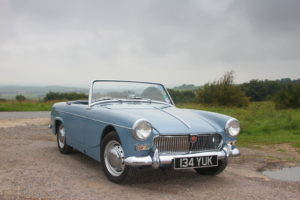
Mk1 Midget
This didn’t last long though for in 1962 a more powerful version was introduced fitted with a 1098cc 56bhp version of the same engine, and in 1963 further improvements arrived in the form of front disc brakes and better interior trim. At this point also the engine received some further refinement by the fitting of larger 2″ main bearings, this was in answer to the criticism of the engine being somewhat rough at higher revolutions. In all other respects the car remained as before, but big changes were to be revealed with the announcement of the MkII model in 1964. This version incorporated a completely new and far more comfortable cockpit, with wind up windows and swivelling quarter-lights, better instrumentation, lockable doors and the option of wire wheels. The biggest change however was to the rear suspension, the quarter elliptic springs being replaced by softer half elliptic’s, resulting in a smoother ride. With the 1098cc engine now producing 59bhp due to a new three branch manifold, larger inlet valves and improved porting, the Midget was becoming sophisticated.
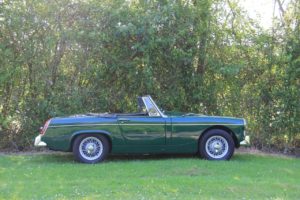
Mk2 Midget
In 1966 yet more power was available by the fitting of the 1275cc 64bhp version of the “A” series engine, unfortunately though not the full 75bhp Cooper ‘S’ version. This model, the MkIII, also benefited from a superb new design of folding hood, and a larger fuel tank.
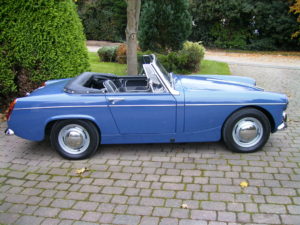
Mk3 Midget
It was at this point however that all further mechanical development of the model sadly came to a halt, it remaining largely unaltered until 1974, although from the Leyland take-over in 1968 there were minor annual styling updates, mostly irrelevant, starting with the application of much matt black paint, a change in bumper design and rear light clusters, “mag” style Rostyle wheels fitted as standard, and a new pattern of seat material in late 1969. In 1970 the Austin Healey Sprite model became just an Austin Sprite, which the following year after just 1022 had been made was dropped altogether. By this time however the two models had become identical in all but badge. Come 1972 and a slightly more notable alteration was made, when rounded rear wheelarches were introduced, a design cue not seen since the original Mark I Frogeye Sprite. Also at this time Rostyle wheels, similar to those fitted to MGB’s were fitted as standard with wires still being offered as an option, and all the interior switches were made to be of the rocker type in the aid of safety.
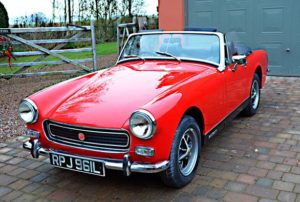
Round Wheel Arch Midget
In late 1974 however the car underwent its final and most significant change, for to keep the model in line with the ever increasing safety and emission rules being introduced in the US, heavy energy absorbing bumpers were fitted along with a 1498cc 65bhp engine from the Triumph Spitfire. This engine was chosen as it had previously passed all US emission specification requirements, and it was unlikely the “A” series would without serious development. This Triumph engine was mated to a fully synchromesh gearbox taken from the Morris Marina range. Marginally more powerful, this final version could in standard form just reach 100mph, something non of the previous standard cars could achieve, although it took a while to get there. Its appearance due to the bumpers was considerably altered, the Midget 1500 also featuring a return to the square design of rear wheel arch. In 1976 wire wheels were dropped from the option list. The car then continued in this guise with just slight annual cosmetic revisions until 1979 when production finally ceased on December 7th.
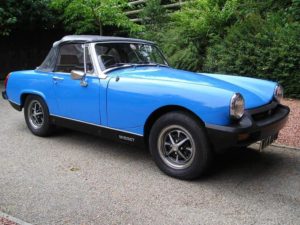
1500 Midget
Usability
Probably the initial and greatest appeal of all Sprites and Midgets is there affordability and very low running costs, but pretty quickly new owners are captivated by the cars pin sharp handling and throttle response. They may not have power to spare but are willing, and at least as far as the “A” series cars are concerned, posses great tune-ability. Indeed these cars can be transformed into seriously quick machines, there being no shortage of tuning shops able to perform wonders. The engines, even when tuned, remain relatively simple and strong, something which can be said of the car in general, although like all late fifties designs, they do suffer from corrosion. This, in common with so many cars of the time, being by far the most expensive problem to overcome. Depending upon how bad the car has suffered, new shells are readily available and very good value, being a cost effective alternative to many hours of costly professional welding. Once the corrosion has been eradicated and thorough modern rust prevention has been carried out and maintained, the problem largely becomes history.
In use all the A series engined cars have a similarity in feel, compact with light and precise steering allowing easy controllable oversteer, a noisy first gear with no synchromesh, they simply cry out to be “driven”. Enormous fun and an absolute joy, the car for any red blooded enthusiast especially if creature comforts are not high on your list of requirements. The earlier MkI models with their quarter elliptic rear suspension are perhaps a tad sharper, but can catch the unwary out as there is less warning when things start getting near the edge. Some enthusiasts consider these the best handling of all the standard cars, even if the ride is a little firmer. The later 1500 models by contrast are much softer and do lose out on the Midgets strongest virtue, its handling, this mostly due to the large heavy bumpers combined with an increase in ride height. This of course can easily be overcome by lowering the suspension, and by what many owners have done, complete removal of those heavy bumpers.
Owning a Midget should cost very little (my kind of car). Any car manufactured before 1st of January 1973 being classed as an historic vehicle and therefore exempt from road tax, even later models made after this date only being charged the lowest rate of £110. Insurance likewise is relatively inexpensive, and with parts costing nothing in comparison to those of modern cars, these diminutive machines continue to give levels of enjoyment out of all proportion to their costs. When set up correctly they will start first time, warm up quickly and transport you anywhere enjoyably, returning at least 35mpg when driven in normal traffic. Bear in mind though they are between 28 to 45 years old, so won’t be quite as reliable as your modern car. They will, and do misbehave, with something often requiring attention at an inconvenient moment. Your ‘modern’ will undoubtedly be more reliable, but nothing like as much fun!
Modifying
With its easily tuneable BMC “A” series engine many tuning shops have offered all manner of performance enhancing modifications since the car was announced. Taurus, Speedwell and Abingdon Special Tuning all offered various levels of tuning from day one. Conversions of the engine swap variety were less common and only two were commercially available during the cars production period. The first from Jack Brabham in 1963 deployed a 1216cc Coventry Climax engine, but was very expensive with few being made, then in 1972 C Conversions from Bedford produced the Atlantis Midget, using a Ford 1600cc GT Kent engine which although less expensive, still sold in relatively small numbers. Now we have companies like Frontline Costello offering all manner of things like five speed gearboxes, modern front end steering and suspension units with multi link rear ends, and engine swaps utilising the fuel injected “K” series engine. Modifications of this calibre move the car into a completely different category and is a subject in its own right. However it cant be stressed to strongly that a properly put together Sprite or Midget with a few period tweaks and a well prepared balanced engine, is a pure joy to drive. Smooth and responsive the car becomes far more than just another form of transport. Great stuff!
Dennis Wharf
MGCC Midget Register
A Potted History of the MG Midget by Rob Cull
The MG Midget as we know it here was produced by the MG Car Company in 1961 and released with a price tag of £669 15s 10d including purchase tax, the last car rolled off the production line in 1979 when the company was under the ownership of British Leyland.
The name “Midget” (in the MG context) was first used in the 1930’s to describe the C Type Midget this was followed by the D Type, J Type…. and so on until the TF Midget in the 1950’s. Today these earlier Midgets are no longer referred to as “Midgets” but are known by thier respective type, i.e. C Type, D Type, T Type etc. Today when people say “Midget” they usually refer to the car made between 1961 and 1982.
The car was really a re-badged Austin Healey Sprite which itself originated from the Frogeye (or Bugeye), Sprites and Midgets are often considered one and the same hence the term Spridget. The Mark 1 Midget when introduced had the 52 bhp 948cc “A” Series engine, perspex sidescreens in place of wind up windows, and a stowaway hood that was completely removed with its frame and stowed in the boot. There were no external door handles driver and passenger had to slide open the side window, to reach inside and operate the door catch from within the overall appearance was sleak but arguably less secure. Both Sprites and Midgets had the square rear wheelarch with quarter eliptic rear springs, a front slatted alluminium radiator grill and sporting a chrome trim strip almost all the way up the centre of the bonnet.
The car received many facelifts over the years in production probably the most striking of these was the change to the 1275cc version of the “A” Series engine in 1966, rated at 65 bhp, the car is most popular with this engine although some drivers prefer the 1098cc with a longer stroke introduced in 1962. The next notable modification was in 1972 when the body styling was changed to rounded rear wheelarches similar to the original Mark I Frogeye Sprite. In 1974 the car changed significantly in appearance and within when the Midget 1500 was launched with the 1500cc engine borrowed from the Triumph Spitfire mated to a gearbox from the Morris Marina, black energy-absorbing bumpers were fitted to front and rear with a return to the squarer rear wheel arch. The car continued in this guise until 1979 when production finally ceased.
So there it is: a potted history. Love it or hate it the Spridget must be one of the most versatile sports cars ever to be produced, from its early beginnings they have been and still are used for race, rally, hillclimb & sprint, trials and auto-test, such a joy to drive easy and cheap to buy and repair. There are not many cars you can say that about.
Rob Cull
